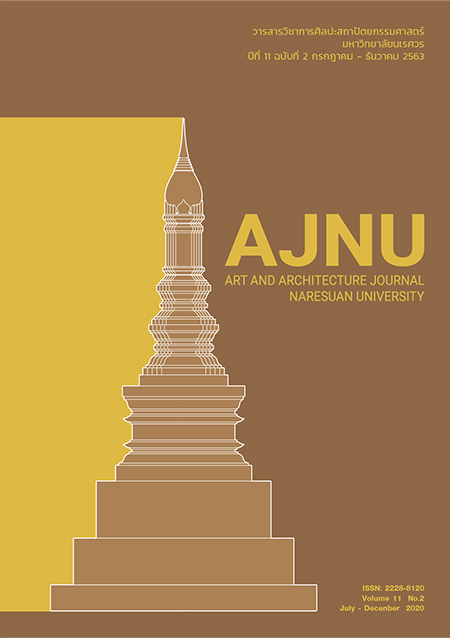Development of creative printmaking from child’s aesthetics expression and content
Main Article Content
Abstract
The creative research: Development of Creative Printmaking from Child’s Aesthetics Expression and Content. The objectives are to study the child’s art artistic expression in their art works on the age between 7-9 years old and to develop creative printmaking. By employs the theories of Victor Lowenfeld and Rhoda Kellogg to analyze and synthesize child artistic expression and use the synthesized art form from child painting for developing individual expression style of the research in contemporary printmaking. This study finds that child art expression generally base on their physical development of hands and fingers to handle a pencil which frequently use dots and lines to draw a simple geometric shape and form with free and sudden expression. Oftentimes, the first object child can draw is the sun and human. Objects in child paintings is rather a representative than an imitative of things from their visual experiences or imagination which the pictures are drawn with the will of narration without any determination of rules , most of the objects float in the air and using a baseline to determine the position. Content in child painting depends on emotional development which mostly combines with their surrounding environment and people. Thus, the expression style and content in child art delivers the sense of purity and honesty, which makes the audiences always feel joyful and happy when viewing the artworks. Especially the Symbolic Stage of child art between 7-9 years old which impression researcher because of the same age as daughter which is researcher’s inspiration. Therefore, collecting data use purposive random sampling by go to school use non-participation observation with child art from daughter’s classmates then analyze and synthesize it to compare with related theories. In the series of printmaking works have synthesized the expression style of childhood artworks and compared side by side with the character of printmaking techniques and finds similarity or linkage between them specifically the use of free and sudden lines in child artworks and Mono-print technique which emphasizes on fast, sudden and agile expression. The content of the new printmaking series, researcher used the story from the surrounding environment and combine with experience from doing various activities which researcher has done together with daughters. Therefore, adapted both artist expression and content such as simple, fast, independent or undecorated of childhood artworks and reorganized them into a new series of artwork through printmaking by mono-print techniques to deliver the sense of fun and happiness to the audiences.
Article Details
References
ชลูด นิ่มเสมอ. (2553). องค์ประกอบศิลปะ (ครั้งที่ 7). กรุงเทพฯ:สำนักพิมพ์อมรินทร์.
ชาญณรงค์ พรรุ่งโรจน์. (2543). การวิจัยทางศิลปะ. กรุงเทพฯ: สำนักพิมพ์แห่งจุฬาลงกรณ์มหาวิทยาลัย.
เทวี ปราสาท. (2546). ศิลปะ รากฐานแห่งการศึกษา เสริมอัจฉริยะให้เจ้าตัวเล็ก. กรุงเทพฯ:มูลนิธิเด็ก.
ประภัสสร นิยมธรรม. (2522). ศิลปะของเด็กเชิงจิตวิทยา. หน่วยศึกษานิเทศก์ กรมการฝึกหัดครู.
ปุณณรัตน์ พิชญไพบูลย์. (2547). ศิลปศึกษา:จากทฤษฎีสู่การสร้างสรรค์. กรุงเทพฯ: สำนักพิมพ์จุฬาลงกรณ์มหาวิทยาลัย.
ศรีเรือน แก้วกังวาล. (2549). จิตวิทยาพัฒนาการชีวิตทุกช่วงวัย แนวคิดเชิงทฤษฎี-วัยเด็กตอนกลาง (ครั้งที่ 9). กรุงเทพฯ: มหาวิทยาลัยธรรมศาสตร์
สัตยา สายเชื้อ. (2541). กิจกรรมศิลปะสำหรับเด็กก่อนวัยเรียน. กรุงเทพฯ: โอ.เอส.พริ้นติ้ง เฮ้าส์.
สี แสงอินทร์. (2558). เทคนิคการสร้างงานภาพพิมพ์ชิ้นเดียว. กรุงเทพฯ: จุฬาลงกรณ์มหาวิทยาลัย.


